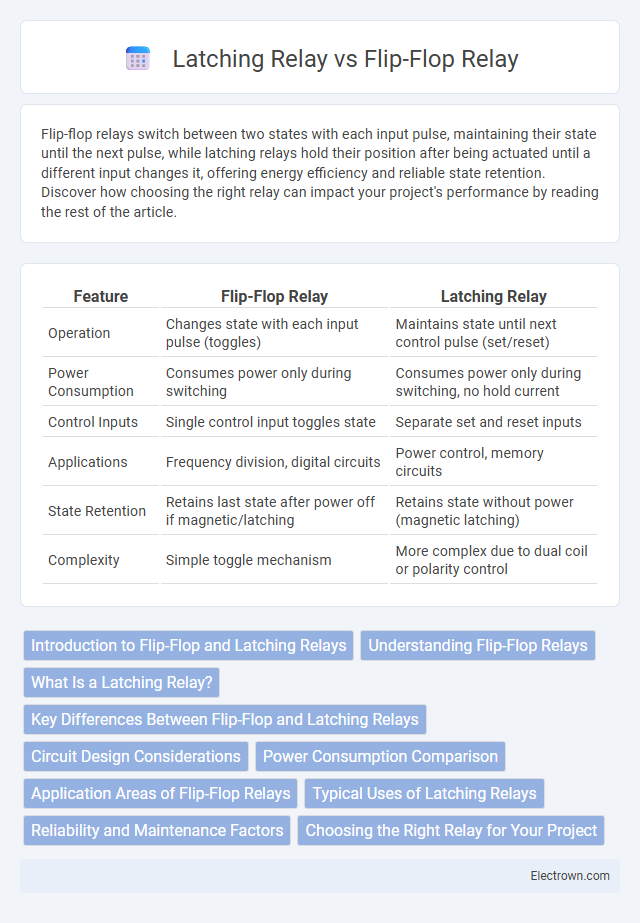Flip-flop relays switch between two states with each input pulse, maintaining their state until the next pulse, while latching relays hold their position after being actuated until a different input changes it, offering energy efficiency and reliable state retention. Discover how choosing the right relay can impact your project's performance by reading the rest of the article.
Table of Comparison
| Feature | Flip-Flop Relay | Latching Relay |
|---|---|---|
| Operation | Changes state with each input pulse (toggles) | Maintains state until next control pulse (set/reset) |
| Power Consumption | Consumes power only during switching | Consumes power only during switching, no hold current |
| Control Inputs | Single control input toggles state | Separate set and reset inputs |
| Applications | Frequency division, digital circuits | Power control, memory circuits |
| State Retention | Retains last state after power off if magnetic/latching | Retains state without power (magnetic latching) |
| Complexity | Simple toggle mechanism | More complex due to dual coil or polarity control |
Introduction to Flip-Flop and Latching Relays
Flip-flop relays are bistable devices that switch their output state with each input pulse, commonly used in digital circuits for toggling functions. Latching relays maintain their contact position even after the control signal is removed, providing energy-efficient switching ideal for memory retention applications. Both relay types are essential in automation and control systems, offering reliable state control with differing mechanisms of operation and power consumption.
Understanding Flip-Flop Relays
Flip-flop relays are electromechanical devices designed to alternate between two stable states each time they receive an activation pulse, enabling control of circuits with minimal input signals. Unlike latching relays, which maintain their position until manually reset, flip-flop relays automatically toggle state, making them ideal for applications requiring toggling control such as memory storage or pulse counting. Understanding the operation of flip-flop relays helps you optimize your circuit designs for efficient switching and reduced power consumption.
What Is a Latching Relay?
A latching relay is an electromechanical switch designed to maintain its position without continuous power, using magnetic or mechanical bistability to stay latched after actuation. Unlike flip-flop relays that switch states with each input pulse, latching relays require separate pulses to set and reset, improving energy efficiency and reducing heat generation. This makes latching relays ideal for applications in low-power systems, lighting controls, and memory retention devices where sustained contact position is critical.
Key Differences Between Flip-Flop and Latching Relays
Flip-flop relays toggle their output state with each input pulse, maintaining the last state until the next trigger, while latching relays use separate coils or inputs to set and reset positions. Flip-flop relays require a single control signal for state change, offering simplified control in memory and switching applications. Latching relays consume no power to hold their state, making them energy-efficient for circuits needing stable retention without continuous power.
Circuit Design Considerations
Flip-flop relay circuit design requires consideration of stable switching states with minimal input pulses, often incorporating debouncing methods to avoid false triggering. Latching relay circuits emphasize energy efficiency, allowing the relay to maintain its state without continuous power by using a pulse to switch positions, critical for battery-operated or low-power applications. Your choice depends on whether you prioritize simple toggling functionality or power conservation in the relay control circuitry.
Power Consumption Comparison
Flip-flop relays typically consume power only during the switching process, making them more energy-efficient for applications requiring infrequent state changes. Latching relays maintain their position without continuous power by using a mechanical latch, resulting in near-zero power consumption in the stable state. Understanding these differences helps you choose the optimal relay type for minimizing power consumption in your control system.
Application Areas of Flip-Flop Relays
Flip-flop relays are extensively used in digital electronics, memory circuits, and control systems where bistable switching is required to maintain an on/off state without continuous power. They play a critical role in applications such as counters, toggle switches, and pulse generation in automation systems. Their reliability in retaining state information makes them ideal for use in industrial machinery control, automotive electronics, and telecommunications equipment.
Typical Uses of Latching Relays
Latching relays are ideal for applications requiring minimal power consumption and maintaining their position without continuous electrical supply, such as lighting controls, elevator systems, and automated equipment. Their ability to retain the last switch position after power loss makes them suitable for use in memory circuits and power-saving devices. You will find latching relays commonly used in scenarios where reliable, energy-efficient switching is essential.
Reliability and Maintenance Factors
Flip-flop relays offer high reliability due to their simple design and minimal moving parts, reducing wear and tear over time. Latching relays provide excellent energy efficiency by maintaining their state without continuous power, which lowers thermal stress and extends operational life. Maintenance demands for flip-flop relays are generally low, while latching relays require less frequent servicing due to their stable hold mechanism, enhancing long-term durability in various applications.
Choosing the Right Relay for Your Project
Selecting between a flip-flop relay and a latching relay depends on your project's specific control and power requirements. Flip-flop relays toggle between two states with each input pulse, ideal for applications needing simple on/off switching without constant power. Latching relays maintain their position after actuation, reducing energy consumption and improving system reliability in projects requiring stable state retention.
flip-flop relay vs latching relay Infographic

 electrown.com
electrown.com